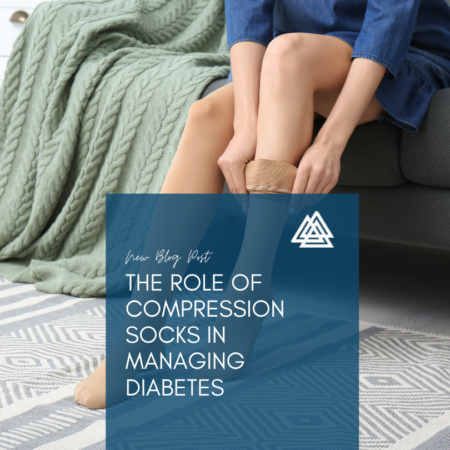Prism Post
 Managing diabetes involves careful attention to various aspects of health, including diet, exercise, and overall circulation. One effective tool in supporting circulation and reducing complications is the use of compression socks. These specialized socks are designed to promote healthy blood flow and alleviate some of the challenges associated with diabetes, such as swelling, poor circulation, and risk of ulcers. Let’s explore how compression socks can support diabetes management and the options available through Prism Medical.
Managing diabetes involves careful attention to various aspects of health, including diet, exercise, and overall circulation. One effective tool in supporting circulation and reducing complications is the use of compression socks. These specialized socks are designed to promote healthy blood flow and alleviate some of the challenges associated with diabetes, such as swelling, poor circulation, and risk of ulcers. Let’s explore how compression socks can support diabetes management and the options available through Prism Medical.
Why Circulation Matters in Diabetes
Diabetes can have a significant impact on your circulatory system, particularly in the legs and feet. High blood sugar levels can lead to:
Nerve Damage (Peripheral Neuropathy): This reduces sensation in the feet, increasing the risk of unnoticed injuries.
Poor Circulation: Reduced blood flow makes it harder for the body to heal wounds and fight infections.
Swelling (Edema): Fluid retention in the lower extremities can cause discomfort and further impair circulation.
Addressing these issues is critical to preventing complications like ulcers, infections, and, in severe cases, amputations. Compression socks can play a vital role in managing these risks.
How Compression Socks Help
Compression socks are not your average socks. They are designed with graduated pressure that is tightest at the ankle and gradually lessens up the leg. Here’s how they work:
Promote Blood Flow:
The gentle pressure helps blood move back toward the heart, reducing pooling in the lower extremities.
Reduce Swelling:
By preventing fluid buildup, compression socks alleviate discomfort and improve mobility.
Support Healing:
Enhanced circulation delivers oxygen and nutrients more effectively to tissues, aiding in wound healing.
Lower Risk of Blood Clots:
Improved blood flow decreases the risk of developing deep vein thrombosis (DVT), a concern for those with limited mobility or poor circulation.
Choosing the Right Compression Socks
Not all compression socks are created equal. Selecting the right pair depends on factors such as compression level, fit, and material. Here are some tips:
Compression Level: Mild (8-15 mmHg) to moderate (15-20 mmHg) compression is often sufficient for diabetes management. Consult with a healthcare provider for guidance.
Material: Look for breathable, moisture-wicking fabrics to prevent irritation and keep feet dry.
Fit: Proper fit is essential. Socks should be snug but not restrictive.
Seamless Design: This prevents friction and reduces the risk of blisters and sores.
Prism Medical’s Compression Sock Offerings
At Prism Medical, we understand the unique needs of individuals managing diabetes. Our range of compression socks includes options tailored for comfort, effectiveness, and style. Here are some highlights:
Gradient Compression Socks:
Provide gentle, graduated pressure to support blood flow.
Designed for everyday wear with a seamless and non-restrictive fit.
Moisture-Wicking Fabrics:
Keep feet dry and reduce the risk of fungal infections.
Variety of Styles and Sizes:
Available in multiple colors and lengths to suit different preferences and lifestyles.
Our team is here to help you select the best socks for your needs. Be sure to check out our size guide to ensure a perfect fit.
Tips for Using Compression Socks Effectively
To get the most out of your compression socks, follow these tips:
Wear Them Daily: Put them on in the morning and remove them before bed for optimal results.
Check Your Skin: Inspect your feet and legs regularly for any signs of irritation or sores.
Wash and Replace: Clean socks after each use and replace them as needed to maintain elasticity.
Take Charge of Your Circulation
Compression socks are a simple yet powerful tool in managing diabetes and promoting overall foot health. By improving circulation, reducing swelling, and supporting healing, they can help you stay active and comfortable.
Ready to take the next step in your diabetes management? Explore more tips on compression socks at www.prism-medical.com and find the perfect fit for your needs. Your feet will thank you!
Disclaimer: Always consult with a healthcare provider before starting any new medical or therapeutic product to ensure it is appropriate for your condition.
 January is Thyroid Awareness Month, a perfect time to focus on one of the most important yet often overlooked glands in your body: the thyroid. This small, butterfly-shaped gland located in your neck plays a critical role in regulating your metabolism, energy levels, and overall health. Let’s explore the vital functions of the thyroid, common disorders, and why regular check-ups are essential for maintaining optimal health.
January is Thyroid Awareness Month, a perfect time to focus on one of the most important yet often overlooked glands in your body: the thyroid. This small, butterfly-shaped gland located in your neck plays a critical role in regulating your metabolism, energy levels, and overall health. Let’s explore the vital functions of the thyroid, common disorders, and why regular check-ups are essential for maintaining optimal health.
What Does the Thyroid Do?
The thyroid produces hormones that influence nearly every organ and system in your body. Key functions include:
Metabolism Regulation: Thyroid hormones determine how quickly your body uses energy from food.
Heart Health: They help control your heart rate and maintain cardiovascular health.
Temperature Control: Your thyroid assists in regulating body temperature.
Growth and Development: It plays a crucial role in childhood growth and brain development.
When the thyroid is functioning properly, you may not even notice it. However, when it’s out of balance, it can significantly impact your health.
Common Thyroid Disorders
Thyroid problems are more common than many people realize, especially in women. Here are some of the most prevalent disorders:
1. Hypothyroidism
What It Is: A condition where the thyroid doesn’t produce enough hormones.
Symptoms: Fatigue, weight gain, cold sensitivity, depression, and dry skin.
Causes: Often linked to autoimmune diseases like Hashimoto’s thyroiditis.
2. Hyperthyroidism
What It Is: When the thyroid produces too much hormone.
Symptoms: Weight loss, rapid heartbeat, anxiety, sweating, and tremors.
Causes: Commonly associated with Graves’ disease or thyroid nodules.
3. Thyroid Nodules
What They Are: Lumps or growths on the thyroid, which may be benign or malignant.
Symptoms: Often asymptomatic, but large nodules may cause difficulty swallowing or breathing.
4. Goiter
What It Is: An enlargement of the thyroid gland.
Symptoms: Visible swelling in the neck and potential difficulty with breathing or swallowing.
Causes: Often linked to iodine deficiency or thyroid dysfunction.
5. Thyroid Cancer
What It Is: Cancer originating in the thyroid gland.
Symptoms: Lump in the neck, hoarseness, or difficulty swallowing.
Prognosis: Highly treatable when detected early.
The Importance of Regular Check-Ups
Thyroid disorders can often go undiagnosed because symptoms are easily mistaken for other conditions. Regular screenings and discussions with your healthcare provider are critical for early detection and effective management. Here’s what to do:
Annual Physical Exams: Ask your doctor to check for thyroid abnormalities during routine check-ups.
Blood Tests: Tests like TSH (thyroid-stimulating hormone) and free T4 can identify thyroid imbalances.
Ultrasound: Imaging may be used to assess nodules or other structural issues.
If you experience symptoms like unexplained fatigue, weight changes, or mood shifts, don’t hesitate to seek medical advice.
Tips for Supporting Thyroid Health
While not all thyroid conditions can be prevented, these steps can help maintain a healthy thyroid:
Eat a Balanced Diet:
Include iodine-rich foods like fish, dairy, and iodized salt.
Incorporate selenium and zinc, found in nuts and seeds, for optimal thyroid function.
Stay Active:
Regular exercise supports overall hormonal balance.
Manage Stress:
Chronic stress can negatively impact thyroid health. Practice relaxation techniques like yoga or meditation.
Avoid Environmental Toxins:
Minimize exposure to chemicals that may disrupt thyroid function, such as BPA in plastics.
Take Action This Thyroid Awareness Month
Your thyroid is small but mighty, and keeping it healthy is key to your overall well-being. This January, take a moment to prioritize your thyroid health by scheduling a check-up, eating a nutrient-rich diet, and staying informed about potential symptoms. Early detection and proactive care can make all the difference.
For more tips and resources, visit https://www.prism-medical.com. Here’s to a healthy and empowered 2025!
 The start of a new year is the perfect time to reflect, reset, and refocus on your health. It’s an opportunity to set achievable goals that can lead to lasting improvements in your physical and mental well-being. But where do you begin? The key to success lies in setting realistic objectives and developing sustainable habits that align with your lifestyle. Let’s explore how to make 2025 your healthiest year yet.
The start of a new year is the perfect time to reflect, reset, and refocus on your health. It’s an opportunity to set achievable goals that can lead to lasting improvements in your physical and mental well-being. But where do you begin? The key to success lies in setting realistic objectives and developing sustainable habits that align with your lifestyle. Let’s explore how to make 2025 your healthiest year yet.
Step 1: Reflect on Your Current Health
Before setting goals, take a moment to evaluate where you are. Ask yourself:
How do I feel physically and mentally?
What habits are helping or hindering my health?
What would I like to improve or change this year?
Reflection helps you identify areas of focus and ensures your goals address your unique needs.
Step 2: Set SMART Goals
Use the SMART framework to create goals that are:
Specific: Clearly define what you want to achieve. Example: “Walk 30 minutes a day, five days a week.”
Measurable: Track your progress. Example: “Drink eight glasses of water daily.”
Achievable: Set goals that challenge you but are within reach. Example: “Lose 5% of my body weight in three months.”
Relevant: Align goals with your overall health vision. Example: “Eat more vegetables to improve my energy levels.”
Time-bound: Set deadlines to stay motivated. Example: “Complete a 5K run by June.”
Step 3: Prioritize Small, Sustainable Changes
Big transformations start with small steps. Instead of overhauling your entire lifestyle, focus on one or two habits at a time. For instance:
Swap sugary drinks for water or herbal tea.
Add one more serving of fruits or vegetables to your daily meals.
Commit to 10 minutes of mindfulness or meditation each day.
Small changes are easier to maintain and build momentum for bigger goals.
Step 4: Create a Support System
Achieving your health goals is easier with the right support. Share your intentions with friends, family, or a healthcare provider. Join fitness classes, online communities, or accountability groups to stay motivated and connected.
Step 5: Embrace Progress Over Perfection
Remember, it’s normal to face setbacks. What matters is your commitment to getting back on track. Celebrate small victories and use challenges as learning opportunities. Consistency, not perfection, leads to lasting change.
Quick Tips for a Healthier 2025
Stay Active: Aim for at least 150 minutes of moderate exercise weekly.
Eat Balanced Meals: Incorporate lean proteins, whole grains, and plenty of colorful produce.
Hydrate: Keep a water bottle handy to encourage hydration throughout the day.
Prioritize Sleep: Establish a bedtime routine to ensure 7-9 hours of quality sleep.
Schedule Check-Ups: Regular health screenings can help catch potential issues early.
Make 2025 Your Year
The journey to better health doesn’t have to be overwhelming. By setting realistic goals and focusing on sustainable habits, you can create a healthier, happier future. Remember, every small step you take is a step toward the best version of yourself.
Here’s to a new year full of growth, wellness, and success. You’ve got this!
Let us help you achieve your health goals! Explore our range of products and resources designed to support your journey at https://www.prism-medical.com
 As the seasons change and temperatures drop, colds become more prevalent. While most colds are mild and self-limiting, some symptoms can signal a more serious underlying condition. Knowing when your sniffles, cough, or fatigue could indicate something more than just a common cold is essential for timely treatment and recovery. In this blog post, we’ll discuss the signs that it could be more than a cold and when to seek medical attention.
As the seasons change and temperatures drop, colds become more prevalent. While most colds are mild and self-limiting, some symptoms can signal a more serious underlying condition. Knowing when your sniffles, cough, or fatigue could indicate something more than just a common cold is essential for timely treatment and recovery. In this blog post, we’ll discuss the signs that it could be more than a cold and when to seek medical attention.
Understanding the Common Cold
The common cold is typically caused by viruses, such as rhinoviruses, coronaviruses, and others. Symptoms usually include:
- Runny or stuffy nose
- Sneezing
- Sore throat
- Cough
- Mild headache
- Fatigue
- Low-grade fever
These symptoms generally resolve within a week or two without requiring medical intervention. However, some symptoms may indicate a more serious illness, such as the flu, bacterial infections, or other respiratory conditions.
Signs It Could Be More Than a Cold
- High Fever
While a mild fever can accompany a cold, a high fever (above 101°F or 38.3°C) lasting more than a few days could indicate a more serious infection, such as the flu or pneumonia. If you experience persistent high fever, it’s essential to consult a healthcare professional.
- Severe or Worsening Symptoms
If your symptoms are worsening instead of improving after a few days, it could be a sign of a more severe condition. Pay attention to increasing severity in:
- Cough (especially if it’s producing green or yellow mucus)
- Chest pain
- Shortness of breath
- Severe sore throat
- Shortness of Breath or Difficulty Breathing
Experiencing shortness of breath or difficulty breathing can indicate respiratory infections, such as bronchitis or pneumonia. If you have a history of asthma or chronic obstructive pulmonary disease (COPD), this is especially concerning. Seek medical attention immediately if you experience these symptoms.
- Chest Pain or Pressure
Chest pain or pressure can be alarming and may indicate a serious condition, such as pneumonia or even a heart problem. If you experience persistent chest discomfort, especially when breathing or coughing, seek emergency medical care.
- Severe Headache or Sinus Pain
While mild headaches are common with colds, a sudden, severe headache or significant sinus pain may indicate a sinus infection or meningitis. If accompanied by fever or stiffness in the neck, this requires immediate medical evaluation.
- Persistent Vomiting or Diarrhea
Gastrointestinal symptoms, such as vomiting or diarrhea, that persist for more than a day or two and are not related to a known gastrointestinal illness could indicate a viral infection. If you are unable to keep fluids down, seek medical attention to prevent dehydration.
- Fatigue and Weakness
While fatigue is common with colds, extreme tiredness or weakness that interferes with daily activities could signal an underlying infection or illness. This could be a sign of flu or other viral infections, requiring a doctor’s evaluation.
- Rash or Skin Changes
If you develop a rash, hives, or other skin changes, especially after a cold, it may be a sign of a viral illness such as measles or a reaction to medication. Seek medical advice if you notice these changes.
- Duration of Symptoms
If your cold symptoms last longer than 10 days without improvement, it might be more than just a cold. Prolonged symptoms could indicate a bacterial infection requiring antibiotics or another underlying condition.
When to Seek Medical Attention
If you experience any of the signs mentioned above, it’s essential to consult with a healthcare provider. In particular, seek immediate medical attention if you have:
- Difficulty breathing
- Severe chest pain or pressure
- A high fever that persists or worsens
- Confusion or altered mental status
- Signs of dehydration, such as decreased urine output or dizziness
Conclusion
While most colds are mild and self-limiting, recognizing the signs that could indicate a more serious condition is crucial for timely treatment. If you’re ever in doubt about your symptoms or how to proceed, don’t hesitate to reach out to a healthcare professional. They can provide guidance, reassurance, and necessary interventions to help you on your path to recovery. Remember, taking care of your health is always a priority, especially during cold and flu season!
 Ankylosing spondylitis (AS) is a chronic inflammatory disease that primarily affects the spine and the sacroiliac joints—the joints connecting the spine to the pelvis. This condition can lead to severe pain and stiffness, significantly impacting an individual’s quality of life. Understanding AS is crucial for those affected and their families, as early diagnosis and effective management can help reduce symptoms and improve mobility. In this blog post, we will explore the causes, symptoms, diagnosis, and treatment options for ankylosing spondylitis.
Ankylosing spondylitis (AS) is a chronic inflammatory disease that primarily affects the spine and the sacroiliac joints—the joints connecting the spine to the pelvis. This condition can lead to severe pain and stiffness, significantly impacting an individual’s quality of life. Understanding AS is crucial for those affected and their families, as early diagnosis and effective management can help reduce symptoms and improve mobility. In this blog post, we will explore the causes, symptoms, diagnosis, and treatment options for ankylosing spondylitis.
What Causes Ankylosing Spondylitis?
The exact cause of ankylosing spondylitis is not entirely understood, but it is believed to be a combination of genetic and environmental factors. Some key points include:
- Genetic Predisposition: A significant number of people with AS carry a specific gene known as HLA-B27. While not everyone with this gene will develop AS, its presence is a strong indicator of susceptibility to the condition.
- Autoimmune Response: AS is considered an autoimmune disease, where the body’s immune system mistakenly attacks healthy cells in the joints and spine, leading to inflammation and pain.
- Environmental Factors: Although the specific triggers for AS are not fully identified, factors such as infections may play a role in initiating the inflammatory response.
Common Symptoms of Ankylosing Spondylitis
The symptoms of ankylosing spondylitis can vary from person to person, but some common signs and symptoms include:
- Chronic Back Pain and Stiffness: This is often the first and most prominent symptom, typically felt in the lower back and buttocks. The pain is usually worse in the morning or after prolonged periods of inactivity.
- Reduced Flexibility: Over time, individuals with AS may experience decreased flexibility in the spine, leading to difficulty bending or twisting.
- Pain in Other Joints: AS can also affect other joints, such as the hips, shoulders, and knees, causing pain and swelling.
- Fatigue: Chronic inflammation can lead to feelings of tiredness and reduced energy levels.
- Eye Inflammation: Some individuals with AS may experience eye problems, such as uveitis or iritis, which can cause redness, pain, and blurred vision.
- Postural Changes: As the condition progresses, the spine may become fused, leading to a stooped posture and a loss of the natural curvature of the spine.
Diagnosis of Ankylosing Spondylitis
Diagnosing ankylosing spondylitis can be challenging, as symptoms may mimic other conditions. Healthcare providers typically use a combination of the following methods for diagnosis:
- Medical History and Physical Examination: A thorough history of symptoms, family history of autoimmune diseases, and a physical examination focusing on spinal mobility and joint pain.
- Imaging Tests: X-rays and MRI scans can help visualize changes in the spine and sacroiliac joints. In the early stages, MRIs may be particularly useful in detecting inflammation that X-rays may not show.
- Blood Tests: Blood tests may be conducted to check for the presence of the HLA-B27 gene and markers of inflammation, such as C-reactive protein (CRP) and erythrocyte sedimentation rate (ESR).
Treatment Options for Ankylosing Spondylitis
While there is no cure for ankylosing spondylitis, various treatment options can help manage symptoms and improve quality of life:
- Medications:
- Nonsteroidal Anti-Inflammatory Drugs (NSAIDs): Over-the-counter NSAIDs, such as ibuprofen or naproxen, can help relieve pain and reduce inflammation.
- Disease-Modifying Antirheumatic Drugs (DMARDs): Medications like sulfasalazine may be prescribed to help slow disease progression, particularly if other joints are affected.
- Biologics: For moderate to severe cases, biologic medications that target specific pathways in the immune system can be highly effective in reducing inflammation and preventing structural damage.
- Physical Therapy: A physical therapist can create a tailored exercise program that focuses on improving flexibility, posture, and strength. Regular exercise is vital for maintaining mobility and reducing stiffness.
- Exercise: Engaging in regular physical activity can help improve spinal flexibility and reduce pain. Low-impact activities such as swimming, walking, and cycling are often recommended.
- Lifestyle Modifications: Maintaining a healthy weight, avoiding smoking, and managing stress through relaxation techniques can also contribute to better symptom management.
- Surgery: In rare cases, surgery may be necessary to correct severe joint damage or deformities that impair mobility.
Living with Ankylosing Spondylitis
Living with ankylosing spondylitis can present challenges, but with appropriate treatment and lifestyle changes, many individuals can lead fulfilling lives. Here are some tips for managing the condition:
- Educate Yourself: Understanding AS and its potential impacts can help you make informed decisions about your treatment and lifestyle.
- Connect with Support Groups: Connecting with others who have AS can provide emotional support, share coping strategies, and offer practical advice.
- Monitor Symptoms: Keep track of your symptoms and discuss any changes with your healthcare provider to adjust your treatment plan as needed.
Conclusion
Ankylosing spondylitis is a chronic condition that can significantly impact daily life, but early diagnosis and a comprehensive management plan can help individuals maintain mobility and improve their quality of life. If you suspect you or a loved one may have AS, seeking medical advice is crucial for effective management. With the right support and treatment, those living with ankylosing spondylitis can lead active, fulfilling lives.
 As the holiday season unfolds, not everyone is filled with cheer and goodwill. For some, the festivities can feel overwhelming, leading to a day that many have humorously dubbed “Humbug Day.” Celebrated on December 21st, Humbug Day serves as a lighthearted reminder to acknowledge the stress and pressures that often accompany the holiday season. Let’s explore the origins of this day, its connection to Charles Dickens, and how to turn a humbug attitude into a positive perspective.
As the holiday season unfolds, not everyone is filled with cheer and goodwill. For some, the festivities can feel overwhelming, leading to a day that many have humorously dubbed “Humbug Day.” Celebrated on December 21st, Humbug Day serves as a lighthearted reminder to acknowledge the stress and pressures that often accompany the holiday season. Let’s explore the origins of this day, its connection to Charles Dickens, and how to turn a humbug attitude into a positive perspective.
The Origin of Humbug Day
Humbug Day is a playful nod to the famous phrase “Bah, humbug!” made popular by Ebenezer Scrooge, the protagonist of Charles Dickens’ classic novella, A Christmas Carol. In the story, Scrooge embodies the spirit of negativity and grumpiness about Christmas, dismissing the holiday as a time for frivolity and nonsense. His disdain for the season becomes a pivotal part of the narrative, as he eventually learns the importance of generosity, compassion, and the joy of giving.
While Humbug Day may seem like an excuse to grumble about the holiday hustle and bustle, it can also serve as a reminder that it’s perfectly okay to feel overwhelmed during this time of year. The day encourages us to acknowledge our feelings—whether they be joy, stress, or a bit of both—and find ways to navigate the holiday season in a healthier, more balanced manner.
Why Do We Feel “Humbug” During the Holidays?
The holidays can be a whirlwind of emotions and activities, often leading to feelings of stress, anxiety, or sadness. Here are some common reasons why people may feel a bit “humbug” during this festive time:
- Overwhelming Expectations: The pressure to create the perfect holiday experience—complete with elaborate decorations, gourmet meals, and thoughtful gifts—can lead to stress and disappointment when reality doesn’t match these expectations.
- Financial Strain: The financial burden of holiday shopping, entertaining, and travel can be daunting, making it easy to feel disheartened when trying to keep up with holiday traditions.
- Family Dynamics: The holidays can bring families together, but they can also bring to light unresolved conflicts or tensions. Navigating these dynamics can be challenging, leading to feelings of frustration or anxiety.
- Self-Care Neglect: In the hustle and bustle of the season, self-care often falls by the wayside. Neglecting our mental and physical well-being can contribute to feelings of burnout or resentment.
Turning “Humbug” into Holiday Cheer
While it’s important to acknowledge the “humbug” feelings that may arise during the holiday season, it’s equally essential to find ways to combat them. Here are some tips for turning your perspective around and embracing the spirit of the season:
1. Practice Self-Care
Make time for yourself amidst the holiday chaos. Prioritize activities that help you relax and recharge, whether it’s taking a walk, reading a book, or enjoying a warm bath. Self-care can help you regain a sense of balance and well-being.
2. Set Realistic Expectations
Let go of the notion of perfection. Focus on what truly matters to you and your loved ones, and simplify your holiday plans. Remember that it’s the thought and connection behind the festivities that counts, not the extravagance.
3. Embrace Gratitude
Shift your focus from what’s causing stress to what you’re grateful for. Consider keeping a gratitude journal where you write down a few things you appreciate each day. This practice can help foster a more positive outlook during the holiday season.
4. Connect with Others
Reach out to friends and family, whether in person or virtually. Share your feelings with loved ones; chances are, they may be experiencing similar emotions. Engaging in heartfelt conversations can help alleviate feelings of isolation and foster a sense of community.
5. Create New Traditions
If the traditional holiday festivities feel overwhelming, consider starting new traditions that resonate more with your current lifestyle. Whether it’s hosting a cozy movie night or participating in a community service project, find activities that bring joy without added pressure.
6. Laugh It Off
Embrace the humor of the season! Share your “humbug” moments with friends and family, and laugh about the little mishaps that occur. Finding the humor in stressful situations can help lighten the mood and create lasting memories.
Conclusion
Humbug Day on December 21 serves as a gentle reminder to acknowledge the challenges that can arise during the holiday season. By recognizing and addressing our feelings, we can create a more meaningful and enjoyable holiday experience. Embrace the spirit of the season, and remember that it’s perfectly okay to feel a bit “humbug” sometimes. With a little self-care, gratitude, and humor, you can transform those feelings into a joyful celebration. So, whether you’re feeling like Scrooge or celebrating with holiday cheer, take a moment to reflect, relax, and embrace the joy of the season!
 Cholesterol-lowering medications, often prescribed to help manage high cholesterol levels, play a crucial role in reducing the risk of heart disease, stroke, and other cardiovascular conditions. While these drugs can be highly effective, they may also come with side effects that can affect a patient’s quality of life. Understanding these side effects is essential for anyone taking cholesterol medications or considering them. In this blog post, we will explore the common side effects associated with cholesterol drugs and what patients can do to manage them.
Cholesterol-lowering medications, often prescribed to help manage high cholesterol levels, play a crucial role in reducing the risk of heart disease, stroke, and other cardiovascular conditions. While these drugs can be highly effective, they may also come with side effects that can affect a patient’s quality of life. Understanding these side effects is essential for anyone taking cholesterol medications or considering them. In this blog post, we will explore the common side effects associated with cholesterol drugs and what patients can do to manage them.
Types of Cholesterol-Lowering Medications
Before discussing side effects, it’s important to understand the different types of cholesterol-lowering medications available. The most commonly prescribed classes of these drugs include:
- Statins: These are the most widely used cholesterol-lowering medications. They work by blocking a substance your body needs to make cholesterol, thereby reducing LDL (low-density lipoprotein) cholesterol levels.
- Bile Acid Sequestrants: These drugs help remove cholesterol from the bloodstream by binding to bile acids in the intestine.
- Cholesterol Absorption Inhibitors: These medications work by preventing the absorption of cholesterol from the food you eat.
- PCSK9 Inhibitors: A newer class of medications that lower LDL cholesterol by enhancing the liver’s ability to remove cholesterol from the blood.
- Fibrates: Primarily used to lower triglycerides and, to some extent, increase HDL (high-density lipoprotein) cholesterol.
- Niacin: This vitamin can help lower LDL cholesterol and triglycerides while raising HDL cholesterol.
Common Side Effects
While many people tolerate cholesterol medications well, some may experience side effects. Here are some common side effects associated with these drugs:
- Muscle Pain and Weakness
- Statins: One of the most reported side effects of statins is muscle pain or weakness, often referred to as myalgia. In some cases, this can escalate to rhabdomyolysis, a rare but serious condition that leads to muscle breakdown and kidney damage.
- Digestive Issues
- Bile Acid Sequestrants and Cholesterol Absorption Inhibitors: These medications can cause digestive problems such as bloating, gas, constipation, and diarrhea. These side effects are often due to changes in bile acid flow or cholesterol absorption in the intestines.
- Liver Damage
- Statins: Elevated liver enzymes can occur in some individuals taking statins, indicating potential liver damage. Regular liver function tests are usually recommended for patients on these medications to monitor any changes.
- Increased Blood Sugar Levels
- Statins: There is evidence suggesting that statin use can lead to a slight increase in blood sugar levels, which may be a concern for individuals with diabetes or those at risk for developing diabetes.
- Skin Reactions
- Niacin: This vitamin can cause flushing, itching, and rashes in some individuals, particularly when taken at higher doses.
- Neurological Effects
- Statins: Some studies have raised concerns about cognitive issues, including memory loss or confusion, although these side effects are generally considered rare and reversible.
Managing Side Effects
If you experience side effects from cholesterol medications, it’s essential to communicate with your healthcare provider. Here are some tips for managing side effects:
- Stay Informed: Understand the potential side effects associated with your specific medication. Being aware can help you identify and report any issues promptly.
- Adjust Dosages: In some cases, adjusting the dosage or switching to a different medication may alleviate side effects. Your healthcare provider can help determine the best approach.
- Incorporate Lifestyle Changes: Dietary changes, regular exercise, and weight management can significantly impact cholesterol levels. These lifestyle modifications may also reduce the need for higher medication doses, potentially decreasing side effects.
- Regular Monitoring: Schedule regular follow-up appointments with your healthcare provider to monitor your cholesterol levels and assess any side effects. Blood tests can help track liver function, muscle enzyme levels, and blood sugar levels.
Conclusion
While cholesterol-lowering medications are essential for managing high cholesterol and reducing the risk of cardiovascular diseases, they can also come with side effects that affect patients’ daily lives. Understanding these side effects, communicating openly with healthcare providers, and adopting a proactive approach to managing them can help patients navigate their treatment journey more effectively. Remember that the benefits of cholesterol medications often outweigh the risks, but it’s crucial to stay informed and involved in your healthcare decisions. If you have concerns about your cholesterol medication or its side effects, don’t hesitate to reach out to your healthcare provider for personalized advice and support.
 As our parents age, the roles we play in their lives often shift. What was once a parent-child relationship may transform into a caregiver dynamic, requiring us to provide support and assistance as they navigate the challenges of aging. While this transition can be rewarding, it can also be overwhelming and emotionally charged. In this blog post, we’ll explore practical tips and strategies for effectively caring for aging parents while maintaining your own well-being.
As our parents age, the roles we play in their lives often shift. What was once a parent-child relationship may transform into a caregiver dynamic, requiring us to provide support and assistance as they navigate the challenges of aging. While this transition can be rewarding, it can also be overwhelming and emotionally charged. In this blog post, we’ll explore practical tips and strategies for effectively caring for aging parents while maintaining your own well-being.
1. Understand Their Needs
The first step in providing care for aging parents is to understand their needs and preferences. Every individual is unique, and their requirements may vary based on health status, lifestyle, and personal choices. Here are some ways to assess their needs:
- Communicate Openly: Engage in honest conversations with your parents about their health, daily routines, and any challenges they may be facing. Encourage them to share their concerns and wishes regarding their care.
- Assess Health Status: Pay attention to their physical and mental health. Consider factors such as mobility, medication management, and cognitive function. This assessment will help you determine what type of support they may need.
2. Create a Care Plan
Once you have a better understanding of your parents’ needs, creating a comprehensive care plan can help ensure they receive the necessary support. Consider including the following elements in your plan:
- Daily Routines: Establish a schedule for meals, medications, and activities to provide structure and predictability.
- Medical Care: Coordinate medical appointments and manage medications. Keep a list of healthcare providers and important medical information readily available.
- Emergency Plan: Develop an emergency plan that outlines steps to take in case of a medical crisis, including contact information for healthcare providers and emergency services.
3. Encourage Independence
While it’s essential to provide support, encouraging independence is equally important. Allowing your parents to maintain their autonomy can boost their self-esteem and improve their overall well-being. Here are some ways to foster independence:
- Involve Them in Decisions: Whenever possible, involve your parents in decisions regarding their care. This empowers them to express their preferences and maintain a sense of control.
- Adapt the Living Environment: Consider making modifications to their home to enhance safety and accessibility. This could include installing grab bars, improving lighting, and removing tripping hazards.
- Promote Social Engagement: Encourage your parents to participate in social activities, hobbies, and community events. Social engagement is vital for mental and emotional health.
4. Prioritize Communication
Maintaining open lines of communication is crucial for ensuring that your parents feel heard and supported. Here are some tips for effective communication:
- Practice Active Listening: Pay attention to what your parents say and validate their feelings. Show empathy and understanding, especially when discussing sensitive topics.
- Address Difficult Topics: Conversations about end-of-life planning, financial matters, and care preferences can be challenging but necessary. Approach these discussions with sensitivity and patience.
- Check-In Regularly: Make it a habit to check in with your parents regularly, whether through phone calls, video chats, or in-person visits. Consistent communication can help you stay informed about their well-being.
5. Seek Support
Caring for aging parents can be emotionally and physically taxing, so it’s essential to prioritize your well-being as well. Here are some ways to seek support:
- Build a Support Network: Connect with family members, friends, or local community organizations who can offer assistance or share experiences. Having a support system can alleviate feelings of isolation.
- Explore Respite Care: Consider respite care options to give yourself a break. Respite care services can provide temporary relief, allowing you to recharge and maintain your own health.
- Access Professional Help: If you’re feeling overwhelmed, don’t hesitate to seek professional assistance. Gerontologists, social workers, and counselors can provide valuable resources and guidance.
6. Take Care of Yourself
Lastly, remember that self-care is vital when caring for aging parents. It’s easy to neglect your own needs while focusing on their well-being, but maintaining your physical and mental health is crucial. Here are some self-care tips:
- Set Boundaries: Establish boundaries to protect your time and energy. It’s okay to say no to additional responsibilities when you need to prioritize your well-being.
- Engage in Stress-Relief Activities: Incorporate activities that help you relax and recharge, such as exercise, meditation, hobbies, or spending time with friends.
- Seek Professional Help if Needed: If you’re feeling overwhelmed or experiencing caregiver burnout, consider talking to a therapist or counselor who can help you navigate your emotions.
Conclusion
Caring for aging parents can be a rewarding yet challenging journey. By understanding their needs, creating a thoughtful care plan, and prioritizing communication and self-care, you can navigate this transition with compassion and support. Remember that you are not alone in this journey, and seeking help when needed is a sign of strength. Embrace this opportunity to strengthen your relationship with your parents while ensuring their well-being and happiness in their golden years.
 Insomnia is a common sleep disorder that affects millions of people worldwide. Characterized by difficulty falling asleep, staying asleep, or waking up too early, insomnia can significantly impact your quality of life, leading to fatigue, irritability, and difficulties with concentration. Fortunately, there are several strategies to help you overcome insomnia and achieve a restful night’s sleep. In this blog post, we’ll explore effective techniques and lifestyle changes that can help you beat insomnia and promote better sleep health.
Insomnia is a common sleep disorder that affects millions of people worldwide. Characterized by difficulty falling asleep, staying asleep, or waking up too early, insomnia can significantly impact your quality of life, leading to fatigue, irritability, and difficulties with concentration. Fortunately, there are several strategies to help you overcome insomnia and achieve a restful night’s sleep. In this blog post, we’ll explore effective techniques and lifestyle changes that can help you beat insomnia and promote better sleep health.
1. Establish a Consistent Sleep Schedule
One of the most effective ways to improve your sleep quality is to establish a regular sleep schedule. Going to bed and waking up at the same time every day helps regulate your body’s internal clock, making it easier to fall asleep and wake up feeling refreshed. Here’s how to create a consistent sleep schedule:
- Set a Fixed Bedtime: Choose a bedtime that allows for 7-9 hours of sleep and stick to it, even on weekends.
- Create a Relaxing Pre-Sleep Routine: Engage in calming activities before bed, such as reading, taking a warm bath, or practicing relaxation exercises. This helps signal to your body that it’s time to wind down.
2. Create a Sleep-Inducing Environment
Your sleep environment plays a crucial role in your ability to fall asleep and stay asleep. Making a few adjustments can significantly enhance your sleep quality:
- Limit Noise and Light: Use blackout curtains to block out light and consider white noise machines or earplugs to minimize disruptive sounds.
- Optimize Temperature: Keep your bedroom cool, ideally between 60-67°F (15-19°C), as a lower temperature is conducive to sleep.
- Invest in Comfortable Bedding: Ensure your mattress and pillows are supportive and comfortable. A good quality mattress can make a significant difference in sleep quality.
3. Limit Screen Time Before Bed
The blue light emitted by smartphones, tablets, and computers can interfere with your ability to fall asleep. Blue light can disrupt the production of melatonin, the hormone that regulates sleep. To promote better sleep:
- Set a Screen Curfew: Aim to turn off all electronic devices at least 30-60 minutes before bedtime.
- Use Blue Light Filters: If you must use screens in the evening, consider using blue light blocking glasses or enable the night mode feature on your devices.
4. Watch Your Diet and Caffeine Intake
What you consume can significantly affect your sleep patterns. Here are some dietary tips to consider:
- Limit Caffeine and Nicotine: Both caffeine and nicotine are stimulants that can interfere with sleep. Try to avoid them in the afternoon and evening.
- Avoid Heavy Meals Before Bed: Eating large or spicy meals too close to bedtime can cause discomfort and disrupt your sleep. Aim to finish eating at least 2-3 hours before going to bed.
- Consider Sleep-Promoting Foods: Incorporate foods rich in tryptophan, magnesium, and melatonin into your diet, such as turkey, nuts, seeds, and cherries.
5. Incorporate Relaxation Techniques
Managing stress and anxiety is essential for combating insomnia. Incorporating relaxation techniques into your daily routine can help you unwind and prepare for sleep:
- Practice Mindfulness and Meditation: Mindfulness practices can help calm your mind and reduce anxiety. Consider using guided meditation apps or practicing deep breathing exercises.
- Try Progressive Muscle Relaxation: This technique involves tensing and relaxing different muscle groups in your body, promoting physical relaxation and reducing tension.
- Engage in Gentle Yoga or Stretching: Gentle yoga or stretching before bed can help release tension in your muscles and prepare your body for sleep.
6. Limit Naps During the Day
While short naps can be refreshing, long or irregular napping during the day can negatively impact nighttime sleep. If you must nap:
- Keep Naps Short: Limit naps to 20-30 minutes to avoid disrupting your nighttime sleep schedule.
- Time Your Naps Wisely: Try to nap earlier in the day rather than in the late afternoon or evening.
7. Seek Professional Help When Needed
If you’ve tried these strategies and still struggle with insomnia, it may be time to consult a healthcare professional. Persistent insomnia can be a sign of an underlying health issue or sleep disorder that requires further evaluation. Your healthcare provider can help identify the root cause and recommend appropriate treatments, which may include cognitive-behavioral therapy for insomnia (CBT-I) or medication.
Conclusion
Beating insomnia requires a multifaceted approach that combines lifestyle changes, sleep hygiene practices, and relaxation techniques. By establishing a consistent sleep schedule, creating a conducive sleep environment, managing your diet, and incorporating relaxation methods, you can significantly improve your sleep quality. Remember that everyone is different, so it may take some time to find the right combination of strategies that work for you. If your insomnia persists, don’t hesitate to seek professional guidance to help you regain control of your sleep and overall well-being. Sweet dreams!
 Hormone therapy (HT) has been a topic of much discussion and debate in the medical community, particularly regarding its impact on women’s health during and after menopause. While it is often prescribed to alleviate menopausal symptoms such as hot flashes and mood swings, its effects on cardiovascular health are complex and warrant careful consideration. In this blog post, we’ll explore how hormone therapy can influence cardiovascular health, the risks and benefits associated with its use, and what women should know when considering this treatment option.
Hormone therapy (HT) has been a topic of much discussion and debate in the medical community, particularly regarding its impact on women’s health during and after menopause. While it is often prescribed to alleviate menopausal symptoms such as hot flashes and mood swings, its effects on cardiovascular health are complex and warrant careful consideration. In this blog post, we’ll explore how hormone therapy can influence cardiovascular health, the risks and benefits associated with its use, and what women should know when considering this treatment option.
Understanding Hormone Therapy
Hormone therapy involves the administration of hormones—typically estrogen, progesterone, or a combination of both—to help manage symptoms associated with hormonal fluctuations, particularly during menopause. HT can take various forms, including:
- Estrogen-only therapy: Often prescribed for women who have had a hysterectomy.
- Combined hormone therapy: Involves both estrogen and progesterone, typically for women who still have their uterus.
- Bioidentical hormones: Compounds that are chemically identical to those produced by the human body, often used in alternative therapies.
Hormone Therapy and Cardiovascular Health
The relationship between hormone therapy and cardiovascular health is multifaceted. Several studies have investigated how HT can affect the risk of heart disease, stroke, and other cardiovascular conditions.
- The Timing Hypothesis
One of the most significant findings in recent research is the “timing hypothesis,” which suggests that the age at which a woman begins hormone therapy can influence its cardiovascular effects. According to this hypothesis:
- Early Initiation: Starting hormone therapy around the onset of menopause may have a protective effect on cardiovascular health. Research indicates that women who initiate HT during this window may experience a lower risk of heart disease compared to those who start later.
- Late Initiation: Conversely, women who begin hormone therapy several years after menopause may have an increased risk of cardiovascular events. This risk is thought to be related to the existing age-related changes in the cardiovascular system and the effects of prolonged estrogen deficiency.
- Impact on Cholesterol Levels
Hormone therapy can positively influence lipid profiles in women. Estrogen is known to:
- Increase HDL Cholesterol: Estrogen therapy has been shown to raise levels of high-density lipoprotein (HDL) cholesterol, often referred to as “good” cholesterol, which helps transport cholesterol to the liver for elimination.
- Lower LDL Cholesterol: Some studies suggest that HT may help lower low-density lipoprotein (LDL) cholesterol, or “bad” cholesterol, contributing to better overall cardiovascular health.
- Effects on Blood Pressure
The impact of hormone therapy on blood pressure is somewhat controversial. Some studies indicate that:
- Estrogen Can Lower Blood Pressure: Estrogen has vasodilatory effects, meaning it can help widen blood vessels, potentially leading to lower blood pressure.
- Risk of Hypertension: In some women, especially those who are older or have pre-existing conditions, hormone therapy may contribute to increased blood pressure. Regular monitoring is essential for women on HT.
- Risk of Thrombosis and Stroke
One of the more significant risks associated with hormone therapy is an increased likelihood of thromboembolic events, including deep vein thrombosis (DVT) and stroke. Factors influencing this risk include:
- Route of Administration: Oral hormone therapy has been associated with a higher risk of blood clots compared to transdermal (patches or gels) or vaginal formulations. This is because oral estrogen can affect the liver’s production of clotting factors.
- Individual Risk Factors: Women with a history of clotting disorders, smoking, obesity, or a family history of cardiovascular disease may face heightened risks when using hormone therapy.
Weighing the Benefits and Risks
When considering hormone therapy, women must weigh the potential benefits against the risks. Some potential benefits of hormone therapy include:
- Relief from menopausal symptoms such as hot flashes, night sweats, and mood swings.
- Improvement in bone density, reducing the risk of osteoporosis.
- Potential protective effects on cardiovascular health if initiated early in menopause.
However, the risks, particularly concerning cardiovascular health, should not be taken lightly. Women should have open discussions with their healthcare providers about their individual health history, risk factors, and goals for hormone therapy.
Conclusion
Hormone therapy can significantly impact cardiovascular health, with both potential benefits and risks. Understanding how hormone therapy affects the cardiovascular system is crucial for women considering this treatment option. The timing of initiation, method of administration, and individual risk factors all play essential roles in determining the outcomes of hormone therapy.
If you’re contemplating hormone therapy as part of your menopause management plan, consult with your healthcare provider to ensure you make informed decisions tailored to your unique health needs. By understanding the nuances of hormone therapy, you can take proactive steps toward maintaining your overall well-being during this transitional phase of life.
